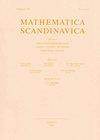A Schwarz lemma for hyperbolic harmonic mappings in the unit ball
IF 0.3
4区 数学
Q4 MATHEMATICS
引用次数: 2
Abstract
Assume that $p\in [1,\infty ]$ and $u=P_{h}[\phi ]$, where $\phi \in L^{p}(\mathbb{S}^{n-1},\mathbb{R}^n)$ and $u(0) = 0$. Then we obtain the sharp inequality $\lvert u(x) \rvert \le G_p(\lvert x \rvert )\lVert \phi \rVert_{L^{p}}$ for some smooth function $G_p$ vanishing at $0$. Moreover, we obtain an explicit form of the sharp constant $C_p$ in the inequality $\lVert Du(0)\rVert \le C_p\lVert \phi \rVert \le C_p\lVert \phi \rVert_{L^{p}}$. These two results generalize and extend some known results from the harmonic mapping theory (D. Kalaj, Complex Anal. Oper. Theory 12 (2018), 545–554, Theorem 2.1) and the hyperbolic harmonic theory (B. Burgeth, Manuscripta Math. 77 (1992), 283–291, Theorem 1).单位球中双曲调和映射的Schwarz引理
假设$p\in[1,\infty]$和$u=p_{h}[\phi]$,其中$\phi\inL^{p}(\mathbb{S}^{n-1},\mathbb{R}^n)$和$u(0)=0$。然后我们得到了某光滑函数$G_p$在$0$处消失的尖锐不等式$\lvert u(x)\rvert \le G_p(\lvert x\rvert)\lvert\phi\rvert_{L^{p}}$。此外,我们在不等式$\lVert-Du(0)\rVert\le C_p\lVert\phi\rVert\le C_p\lVert\phi\r Vert_{L^{p}}$中得到了尖锐常数$C_p$的显式形式。这两个结果推广和推广了调和映射理论(D.Kalaj,Complex Anal.Oper.theory 12(2018),545–554,定理2.1)和双曲调和理论(B.Burgeth,Manuscripta Math.77(1992),283–291,定理1)的一些已知结果。
本文章由计算机程序翻译,如有差异,请以英文原文为准。
求助全文
约1分钟内获得全文
求助全文
来源期刊

Mathematica Scandinavica
数学-数学
CiteScore
0.60
自引率
0.00%
发文量
19
审稿时长
>12 weeks
期刊介绍:
Mathematica Scandinavica is a peer-reviewed journal in mathematics that has been published regularly since 1953. Mathematica Scandinavica is run on a non-profit basis by the five mathematical societies in Scandinavia. It is the aim of the journal to publish high quality mathematical articles of moderate length.
Mathematica Scandinavica publishes about 640 pages per year. For 2020, these will be published as one volume consisting of 3 issues (of 160, 240 and 240 pages, respectively), enabling a slight increase in article pages compared to previous years. The journal aims to publish the first issue by the end of March. Subsequent issues will follow at intervals of approximately 4 months.
All back volumes are available in paper and online from 1953. There is free access to online articles more than five years old.
 求助内容:
求助内容: 应助结果提醒方式:
应助结果提醒方式:


